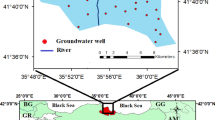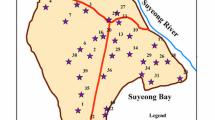Abstract
A study was employed to evaluate the probable sources of heavy metal in the groundwater along the mountain front (MF) and riparian zone (RZ) using statistical techniques. 53 samples have been collected and analyzed for major ions and 16 heavy metals like Li, Be, Al, Ti, Cr, Fe, Mn, Cu, Cd, Zn, Ga, Rb, Sr, Cs, Ba and Pb. Samples along MF exceeded the permissible limits for metals like Li, Ti, Al, Cr, Fe, Sr, Cd, Ba and Pb with a maximum concentration of 30.10, 42,823, 378, 74.53, 30,801, 5970, 10.88, 1052.69 and 4458, respectively (WHO in Guidelines for drinking-water quality, First adendum to third ed., Recommendations, vol 1. WHO, Geneva 2006 and WHO in Guidelines for drinking-water quality (4th ed.). http://www.whqlibdoc.who.int/publications/2011/9789241548151_eng.pdf 2011). However, samples along the RZ exceeds the prescribed limits for the same metals as MF except Ba. Specific metals in groundwater like Cr, Cu, Ti, Mn and Pb, reflect anthropogenic signatures (agrochemicals and urban sewage); however, other metals are due to natural process, i.e., leaching of underlying rocks. Thus, both MF and RZ aquifers are highly influenced by the recharge from natural process, agricultural return flow and urban sewage. High saturation index of gibbsite is noted along the MF and it reveals the stages of initial weathering and predominance recharge zones as compared to RZ.
Similar content being viewed by others
References
Alloway BJ, Jackson AP (1991) The behavior of heavy metals in sewage sludge-amended soils. Sci Total Environ 100:151–176
Anderson SP, Dietrich WE (2001) Chemical weathering and runoff chemistry in a steep headwater catchment. Hydrol Process 15(10):1791–1815
Balasubramanian A, Sastri JCV (1994) Groundwater resources of Tamirabarani River basin. Inland Water Resources, Tamil Nadu, India, pp 484–501
Ball JW, Nordstrom DK (1991) User’s manual for WATEQ4F, with revised thermodynamic data base and test cases for calculating speciation of major, trace, and redox elements in natural waters. U.S. Dept. of the Interior, Geological Survey, pp 91–183
Banaja P, Chidambaram S, Ganesh N (2017) An attempt to understand the subsurface variation along the mountain front and riparian region through geophysics technique in South India. Model Earth Syst Environ. https://doi.org/10.1007/s40808-017-0334-8
Beaumont JJ, Sedman RM, Reynolds SD, Sherman CD, Li LH, Howd RA, Alexeeff GV (2008) Cancer mortality in a Chinese population exposed to hexavalent chromium in drinking water. Epidemiology 19(1):12–23
Begemann F, Libby WF (1957) Continental water balance, ground water inventory and storage times, surface ocean mixing rates and world-wide water circulation patterns from cosmic-ray and bomb tritium. Geochim Cosmochim Acta 12(4):277–296
Biney CA, Christopher AB (1991) Trace metal concentrations in fish and sediments from the WIWI: a small urban river in Kumasi, Ghana. Trop Ecol 32(2):197–206
Bradley SB, Cox JJ (1986) Heavy metals in the Hamps and Manifold valleys, North Staffordshire, U.K.: distribution in floodplain soils. Sci Total Environ 65:105–128
Breward N, Apostol A, Appleton JD, Gomez R, Miguel J (1996) Mercury and other heavy-metal contamination associated with gold mining in the Agusan river catchment, Mindanao, the Philippines. British geological survey, Overseas geology series technical report WC/96/61/R, Keyworth, Nottingham
Brown-Adiuku ME, Ogezi AE (1991) Heavy metal pollution from mining practices: a case study of Zurak. J Min Geol 27(2):205–211
Caboi R, Cidu R, Fanfani L, Lattanzi P, Zuddas P (1999) Environmental mineralogy and geochemistry of the abandoned Pb-Zn Montevecchio-Ingurtosu mining district, Sardinia, Italy. Chron Rech Min 534:21–28
CGWB (2009) District groundwater brochure Tirunelveli district, Tamil Nadu. Technical Report Series. CGWB, Tamil Nadu, p 5
Chidambaram S (2000) Hydrogeochemical studies of groundwater in Periyar district, Tamilnadu, India. Department of Geology, Annamalai University, Tamilnadu
Chidambaram S, Karmegam U, Prasanna MV, Sasidhar P, Vasanthavigar M (2011) A study on hydrochemical elucidation of coastal groundwater in and around Kalpakkam region, Southern India. Environ Earth Sci 64:1419–1431 (ISSN 1866-6280)
Chidambaram S, Anandhan P, Prasanna MV, Ramanathan AL, Srinivasamoorthy K, Senthil Kumar G (2012a) Hydrogeochemical modelling for groundwater in Neyveli Aquifer, Tamil Nadu, India. Using PHREEQC: a case study. Nat Resour Res 21(3):311–324
Chidambaram S, Prasanna MV, Singaraja C, Thilagavathi R, Pethaperumal S, Tirumalesh K (2012b) Study on the saturation index of the carbonates in the groundwater using WATEQ4F, in layered coastal aquifers of Pondicherry. J Geol Soc India 80(6):813–882
Chidambaram S, Anandhan P, Prasanna MV, Srinivasamoorthy K, Vasanthavigar M (2013) Major ion chemistry and identification of hydrogeochemical processes controlling groundwater in and around Neyveli Lignite Mines, Tamil Nadu. South India. Arab J Geosci 6(9):3451–3467
Clark ID, Fritz P (1997) Environmental isotopes in hydrogeology. CRC press
Davis JC (1973) Statistics and data analysis in geology. John Wiley and Sons Inc., New York
Demirel Z (2007) Monitoring of heavy metal pollution of groundwater in a phreatic aquifer in Mersin-Turkey. Environ Monit Assess 132(1):15–23
Dong SZ, Chen CZ, Li DM, Sun YS (1993) A study of hygienic standard for titanium in the source of drinking water. Zhonghua Yu Fang Yi Xue Zhi 27(1):26–28 (Chinese journal of preventive medicine)
Drury CF, Stone JA, Findlay WI (1991) Microbial biomass and soil structure associated with corn, grasses and legumes. Soil Sci Soc Am J 55:805–811
Edet AE, Ntekim EEU (1996) Heavy metal distribution in groundwater from Akwa Ibom State, eastern Niger delta—a preliminary pollution assessment. Glob J Pure Appl Sci 2(1):67–77
Ficklin WH, Plumlee GS, Smith KS, McHugh JB (1992) Geochemical classification of mine drainages and natural drainages in mineralized areas. Water-rock Interact 1:381–384
Gibbs RJ (1970) Mechanisms controlling world water chemistry. Science 170(3962):1088–1090
Hanson RT (2003) Geohydrologic framework of recharge and seawater intrusion in the Pajaro Valley, Santa Cruz and Monterey Counties, California. US Department of the Interior, US Geological Survey
Hooper K, Iskander M, Sivia G, Hussein F, Hsu J, Deguzman M, Odion Z, Ilejay Z, Sy F, Petreas M, Simmons B (1998) Toxicity characteristic leaching procedure fails to extract oxoanion-forming elements that are extracted by municipal solid waste leachates. Environ Sci Technol 32:3825–3830
Huang SW, Jin JY (2008) Status of heavy metals in agricultural soils as affected by different patterns of land use. Environ Monit Assess 139(1):317–327
IARC (2012) IARC monographs on the evaluation of carcinogenic risks to humans. A review of human carcinogens: arsenic, metals, fibres, and dusts, vol 100C. International agency for research on cancer, Lyon, pp 121–141
Karim Z (2011) Risk assessment of dissolved trace metals in drinking water of Karachi, Pakistan. Bull Environ Contam Toxicol 86(6):676–678
Krishna AK, Govil PK (2007) Soil contamination due to heavy metals from an industrial area of Surat, Gujarat, Western India. Environ Monit Assess 124(1–3):263–275
Lenntech (2017) Periodic table. http://www.lenntech.com/periodic/elements. Accessed 30 Jan 2017
Lukaski HC, Johnson PE (1985) A simple, inexpensive method of determining total body water using a tracer dose of D2O and infrared absorption of biological fluids. Am J Clin Nutr 41(2):363–370
MDH (1999) Screening evaluation of arsenic, cadmium, and lead levels in Minnesota fertilizer products. Department of Health, Minnesota
Panda B, Chidambaram S, Tirumalesh K, Ganesh N, Thivya C, Thilagavathi R, Venkatramanan S, Prasanna MV, DevarajN Ramanathan AL (2019) An integrated approach to understand the process of mountain front recharge and riparian zone aquifer system in Tamil Nadu, India: a first report. Aquat Geochem. https://doi.org/10.1007/s10498-019-09357-8
Papanikolaou NC, Hatzidaki EG, Belivanis S, Tzanakakis GN, Tsatsakis AM (2005) Lead toxicity update. A brief review. Med Sci Monit 11(10):329–336
Prasanna MV, Chidambaram S, Pethaperumal S, Srinivasamoorthy K, John Peter A, Anandhan P, Vasanthavigar M (2008) Integrated geophysical and chemical study in the lower sub basin of Gadilam River, Tamilnadu, India. Environ Geosci 15(4):145–152
Rajgopal R (1984) Ground-water quality assessment for public policy in India. First annual report. Department of Geography, IOWA Univeristy, IOWA
Siepak M, Niedzielski P, Bierła K (2004) Determination of inorganic speciation forms of arsenic, antimony and selenium in water from a grate ashes dumping ground as an element of hydrogeochemical monitoring of pollution spread. Pol J Environ Stud 13(6):709–713. http://www.pjoes.com/pdf/13.6/709-713.pdf
Singh VS, Mondal NC, Ron Barker, Thangarajan M, Rao TV, Subrahmanyam K (2003) Assessment of groundwater regime in Kodaganar river basin (Dindigul District, Tamilnadu). Unpublished Tech. Report. 2003-GW-269, 104
Skoryna SC (1981) Effects of oral supplementation with stable strontium. Can Med Assoc J 125(7):703
Stumm W, Morgan JJ (1996) Aquatic chemistry: chemical equilibria and rates in natural waters {environmental science and technology}. Wiley, Hoboken
Subramani T, Elango L, Damodarasamy SR (2005) Groundwater quality and its suitability for drinking and agricultural use in Chithar River Basin, Tamilnadu, India. Environ Geol 47:1099–1110
Swan AR, Sandilands M (1995) Introduction to geological data analysis. Int J Rock Mech Min Sci Geomech Abstr 8(32):387
Thuyet DQ, Saito H, Saito T, Moritani S, Kohgo Y, Komatsu T (2016) Multivariate analysis of trace elements in shallow groundwater in Fuchu in western Tokyo Metropolis, Japan. Environ Earth Sci 75:559
Voutchkova DD, Schullehner J, Knudsen NN, Jorgensen LF, Ersboll AK, Kristiansen SM, Hansen B (2015) Exposure to selected geogenic trace elements (I, Li, and Sr) from drinking water in Denmark. Geosciences 5(1):45–66
Walna B, Siepak M (2012) Heavy metals: their pathway from the ground, groundwater and springs to Lake Go´reckie (Poland). Environ Monit Assess 184:3315–3340
WHO (2004) Guidelines for drinking water quality, 3rd edn. Recommendation, vol 1. Geneva
WHO (2006) Guidelines for drinking water quality, First adendum to third ed., Recommendations, vol 1. WHO, Geneva
WHO (2011) Guidelines for drinking-water quality (4th ed.). http://www.whqlibdoc.who.int/publications/2011/9789241548151_eng.pdf. Accessed 15 Jan 2011
Wu B, Zhang Y, Zhang X, Cheng S (2010) Health risk from exposure of organic pollutants through drinking water consumption in Nanjing, China. Bull Environ Contam Toxicol 84:46–50
Xibao C, Shen Z, Licheng Z (1996) A study of the physicochemical speciation of heavy metals in waters of rivers and lakes in the Changjiang River valley, China. GeoJournal 40(1–2):187–195. https://doi.org/10.1007/BF00222544
Yu X, Tong S, Ge M, Wu L, Zuo J, Cao C, Song W (2013) Adsorption of heavy metal ions from aqueous solution by carboxylated cellulose nanocrystals. J Environ Sci 25(5):933–943
Acknowledgements
The authors would like to thank, The Science and Engineering Research Board (SERB), New Delhi (No: SB/S4/ES-699/2013) for providing necessary financial support to carry out this study and the author Banajarani Panda wish to express her sincere thanks to Department of Science and Technology for providing the Inspire fellowship (No: DST/INSPIRE Fellowship/[IF150615], 27th October 2015).
Author information
Authors and Affiliations
Corresponding author
Additional information
Publisher's Note
Springer Nature remains neutral with regard to jurisdictional claims in published maps and institutional affiliations.
Rights and permissions
About this article
Cite this article
Panda, B., Chidambaram, S., Thivya, C. et al. An attempt to determine the behavior of metals and their dependent thermodynamic saturation states in the groundwater along mountain front and riparian zone. Environ Earth Sci 79, 17 (2020). https://doi.org/10.1007/s12665-019-8685-2
Received:
Accepted:
Published:
DOI: https://doi.org/10.1007/s12665-019-8685-2













